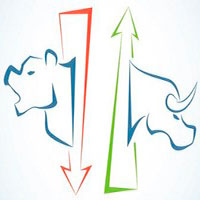Forex hedging is a risk management strategy that offsets potential losses by taking opposite positions. It involves placing trades that serve as a safeguard against adverse price movements, minimizing the overall risk exposure. It’s a simple concept at first glance. Whenever your trade starts to lose or you fear the markets are going contrary to your forecast, have a buy order and a sell order active at the same time. No matter what the markets do next, you can’t lose more. Sounds foolproof, right?
Retail traders, big companies, and even banks use a forex hedging strategy, but is it worth it for you? Let’s find out.
Forex hedging strategy in action
Let's say EURUSD has been trending down for a while and you see that trend weakening. You buy 1 lot of EURUSD in anticipation of a reversal, but the price keeps falling. Your losses increase, threatening your overall equity, but if you close the order, then the chances of recuperating your losses and even profiting are gone. This is where forex hedging comes in.
By adding a sell order of 1 lot to your portfolio, you can’t lose more, even in the face of a massive rally or crash. You are protecting your equity from even the most radical volatility.
Adverse trends eventually break, and when the price finally moves in the right direction for your buy order, the hedging sell order can be closed, leaving your original order to ride the bullish wave. Hedging with a contradictory order is effective at protecting your trading account from a catastrophic loss, but there are other ways to hedge your orders. There are assets known to have an inverse correlation with each other, and such a forex hedging strategy can help to diversify your portfolio.
Cross-currency pairs hedging
Traders can also hedge by using correlated currency pairs that move in opposite directions. If they are long on one pair, they can short a related pair to hedge their exposure. The rule of thumb for identifying a possible forex hedging asset is to check the base currency and quote currency. For EURUSD, EUR (euro) is the base currency, USD (US dollar) is the quote currency. If you want to hedge EURUSD, look for a currency pair where USD is the base currency then check the charts to see if there is a correlating price action.
For example, If EURUSD is falling, meaning that the euro is weakening against the US dollar, a currency pair that tends to have an inverse correlation with EURUSD is USDCHF. In this scenario, USDCHF would likely be rising as the US dollar appreciates against the Swiss franc.
By going long on USDCHF, a trader could potentially hedge against losses incurred from the falling EURUSD trade, diversifying their portfolio in the process.
Is hedging forex foolproof?
A forex hedging strategy is powerful and can save traders a lot of heartache, but it’s not a guaranteed profit generator. It’s also not foolproof. Timing is tricky and a bad hedging entry can cost you. Yes, you can cancel your hedging order when the price reaches your original buy order level, but then you’re back to square one. The price can fall once again, and often does, meaning you might end up trading all day just to keep your equity unchanged.
Every time you open and close a hedging order, you must pay the price of the spread. A broker’s spread is usually dynamic and tends to widen during volatility, which means trading costs are higher when hedging is most needed.
Timing is also important. The time to open the hedging order is debatable and a personal preference connected to the trader’s risk appetite. The most common level at which a trader considers a hedging order is when the price reaches 30 pips in the wrong direction. For example, EURUSD price falls by 30 pips from 1.09200. The short hedge would be opened at 1.08900. Traders may sit on both orders until the short hedging position returns to zero before closing the order. If the downtrend is significant, both orders may remain open for a long time.
The pros of hedging forex
There are very few benefits to a forex hedging strategy. If you value peace of mind and wake in the middle of the night to check on a risky open position, hedging will help you get a better night's sleep. Knowing that you cannot lose more is comforting, but hedging will never result in profit: it will only mitigate the risk of losses.
The cons of hedging forex
Hedging forex increases the complexity of your orders and your trading costs. These costs can eat into potential profits. Following a forex hedging strategy, a trader cannot profit, but having two orders open means twice the spread, and twice the cost. Forex hedging commonly leads to trading indecision. Traders might struggle to manage positions moving in opposite directions, creating confusion and stress.
Worst of all, hedging forex can tie up trading capital, due to the simultaneous opening of opposing positions. This can impact a trader's ability to take advantage of other trading opportunities.
For less volatile currency pairs, opening a forex hedging order can commit your available equity to an order that could stay in limbo for weeks or even months. And when a must-act market opportunity shows up, you’ll face a very tough decision.
Conclusion
The cons of a forex hedging strategy outweigh the pros when prioritizing profit over peace of mind. But a common downfall for new traders is getting hit by one terrible choice. Traders can perform well for days or weeks accumulating profit and then get stopped out in a single day because of one shocking price action.
Hedging forex allows traders to live another day, which is needed to make small gains over time and allow a trading account to grow. In the end, it’s all about what you value the most. Do you prefer better potential profitability or a safer trading strategy that, at worst, will result in minor losses?
If you choose not to use a forex hedging strategy, setting Stop Loss can also protect you from extreme losses, but you may miss out on long rallies and short crashes if your SL settings are too tight. In addition, the Exness Stop Out Protection feature is designed to reduce the risk of stop outs caused by extreme volatility. Whichever way you choose to trade, always prepare for an unexpected and extreme price action.

















